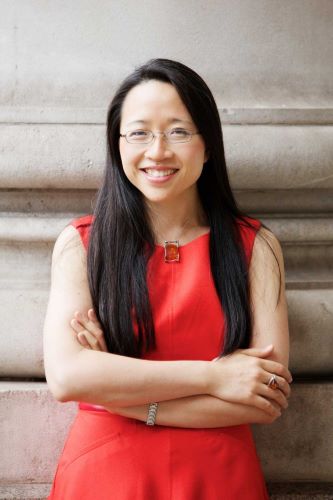
Exploration and Play with Math
By Eugenia Cheng
I love visiting elementary schools and giving math talks to children. I love mentioning math to a class of six-year- olds and seeing their reaction, which often involves them screaming with excitement and physically jumping up and down. When I ask them a question they can barely suppress the urge to shout out the answer, and will almost dislocate their shoulder raising their arm higher and higher in the air. This is all a rather sharp contrast with typical undergraduate math classes, in which students are more likely to hide at the back and keep their heads down, desperately hoping not to be called on.

Apparently something unfortunate happens to too many people in between first grade and university, resulting in their early excitement for math being turned into fear. It’s often because math makes them feel stupid. They’re not as fast as other students, they can’t solve the problems, they don’t score as highly on tests, and they are bothered by questions they want to ask but that never get answered.
This is why I feel it is so important to talk to young children about math, to try and preserve that initial excitement, rather than wait for it to get squashed and then try and intervene to fix the situation later.
I love talking to children about math that might be considered “high level”. So I don’t just talk about numbers and arithmetic, but also things like infinity, different types of symmetry, tessellations, convergent sequences, logical paradoxes, higher-dimensional space—although I might not use exactly those terms. It might seem that those things are much too hard for children, and they won’t be able to understand them. But the thing is that actually nobody can really understand those things! For me the aim isn’t to finish understanding them, but to start. It’s to stretch our brains and expand our curiosity by thinking about them. I don’t think we stretch ourselves if we only think about things we can understand. When I was growing up my piano teacher always gave me pieces to learn that were slightly too hard for me, and that’s how I got better. Of course, there still needs to be something to latch onto—we can’t just hand a child a graduate text book and think they’ll learn anything. But for me one of the beautiful things about abstract math is that the basic ideas are very simple, and what’s really hard is pinning them down in a logically rigorous way. But that means we can talk about the basic ideas with children, even if the rigorous part has to wait.

The basic ideas often involve a lot more creativity, imagination, and dreaming than is usually associated with math. I think that’s a really important part of talking about math with children—to give them a sense that they can be involved, that they can have agency, that they can make things for themselves. Too many children are only shown rule-based math, and think that creativity only happens in writing stories, drawing pictures, singing, dancing, making things. Some children might like rules and clear answers, and so they do enjoy rule-based math, but in the end that’s not what math is really about. Somehow in the math curriculum, math is about exploration and play right at the beginning, and then it becomes all about rules in the middle, and only if you make it through the rule-based part do you get to research, where it becomes about exploration and play again.
I think we shouldn’t be so hierarchical about math and think that you have to be able to do certain things before you can be shown other things. That is sometimes a little bit true; for example, it’s probably futile trying to think about addition of two-digit numbers if you can’t add one-digit numbers yet. But the “high-level” ideas I mentioned above don’t have anything to do with arithmetic, so we can talk about them with children who can’t do arithmetic yet.
And very importantly, I hope adults will feel they can talk to children about math that they, the adults, don’t understand themselves. Because none of us really understands it; in math there is always more to understand. My book touches on parts of math that many adults may feel they don’t understand themselves, but that’s ok! In fact I think it’s crucial to be open to talking with children about things we don’t understand, to demonstrate openness to understanding more, and to go exploring together. I think it’s like the fact that we can listen to music with children even if we can’t play music. We can show children beautiful pictures even if we can’t draw them ourselves. We can eat and appreciate food that we don’t know how to make.
I think just about everyone knows that reading to children is a good thing to do, and we read them compelling stories, not grammar exercises. We expand their vocabulary by reading them stories with words they don’t understand, and if we find we can’t explain a word ourselves we don’t abandon the book, but hopefully we show them how to look words up and we share with them the pleasure of learning new things. We can do that with math too.





Text and images are courtesy of Eugenia Cheng and may not be used without expressed written consent.

As a math teacher, I have thoroughly enjoyed Eugenia’s writings for years. I pass on her works to studenrs.